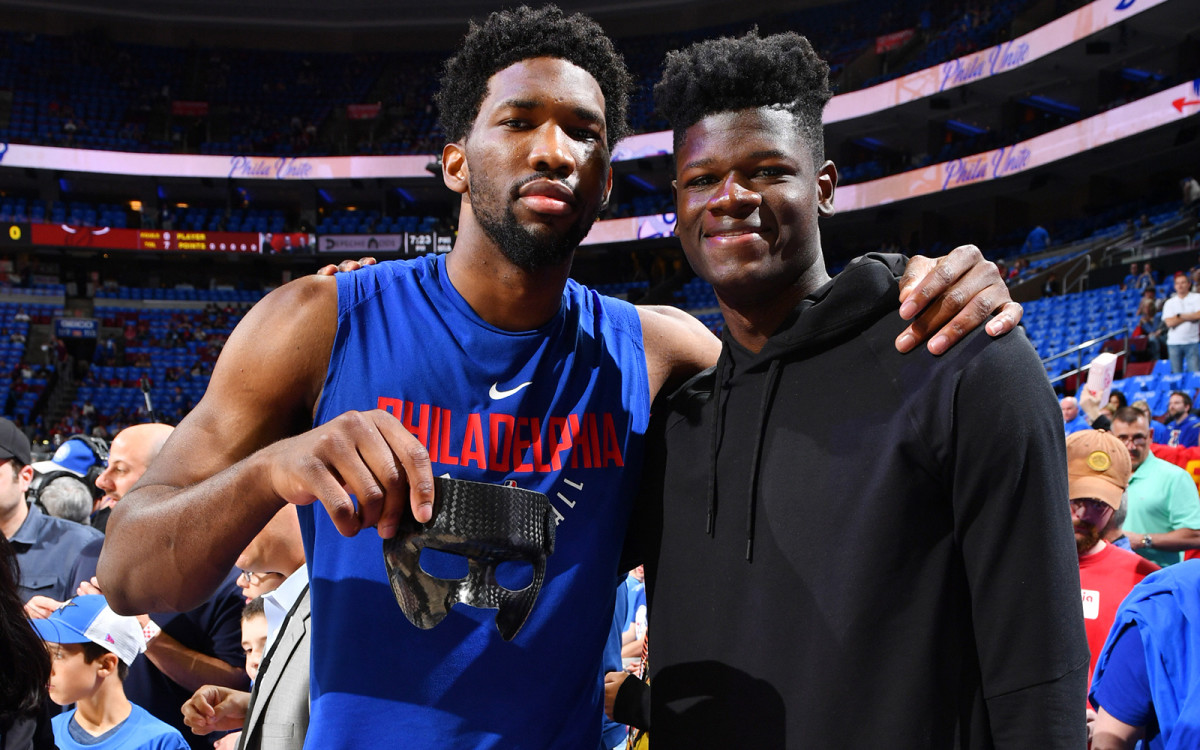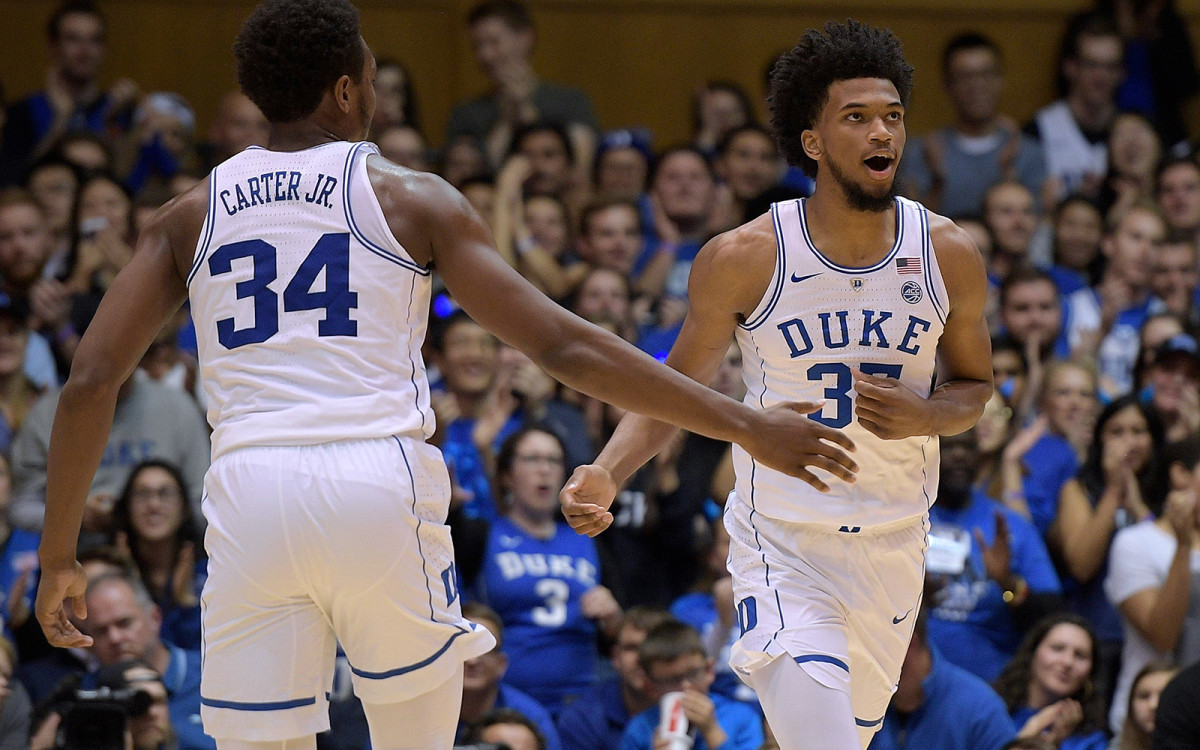The NBA Draft and the Impossible Standards of the Warriors Era

For the past four years, we've seen the best teams in the NBA render big men useless over and over again in the playoffs. The only centers who can survive are undersized and ultra-versatile, as comfortable on the perimeter as they are inside. Now the 2018 draft is here, and everyone at the top of the board is selling themselves on traditional centers like Mo Bamba, Deandre Ayton and Marvin Bagley.
If you think this dissonance looks irrational and borderline irresponsible, you're not crazy. But as a nation of fans wonder how anyone could use top–five picks on traditional big men during the Warriors era, what's actually happening isn't quite as simple as a bunch of bad teams ignoring the direction of the sport. Instead, the top of this draft speaks to just how wide the gap has become between the top of the league and everyone else. But there are a few different threads to this discussion—"Why draft a big man in the smallball era?"—so let's break this down in sections.
1. The most convincing theory... for buying into the next 10 years of players like Ayton, Bamba, and Bagley is that the league we have now won't necessarily be what the sport looks like midway through the next decade. If you're investing in a 19-year-old superstar, it would be stupid to make the decision based strictly on what he can offer over the next three years. As the Warriors recede, new powerhouses will emerge, and chances are good that the team or teams filling that vacuum will have superstar big men. So maybe it's not crazy to build with an eye toward that future, betting on a shift to a more natural balance between superstar big men and playoff games dominated by wings and guards.
I want to buy into that future. Dominant big men are fun to watch, while conversely, it's been a little bit depressing to watch those players routinely marginalized in every game that matters. I'm tired of reading tweets about "today's NBA" on Twitter, where almost every day someone casually dismisses the entire career of an otherwise incredible basketball player who nonetheless struggles to keep pace with the Rockets, Celtics, and Warriors. We've had that conversation about Nikola Jokic, Karl Towns, Kevin Love, and even Rudy Gobert, who's about to win Defensive Player of the Year next week.
All these discussions make me desperate for a someone to come through and dunk the smallball era into oblivion. Think back to Joel Embiid at the NBA All-Star Game in February, flexing on both ends in the fourth quarter, looking like one of the five best players on the planet. That's a player whose dominance makes the whole sport more interesting.
It's tough, though. Every year now, the playoffs begin and the games become a race to see who downsizes quickest. Even the best big men struggle to keep pace. And while it's possible that new contenders with different roster constructions will change this story in the next decade, it's hard to keep the faith. I watch Celtics and Warriors teams full of wings and mobile bigs, and it looks like they've hacked basketball and started trends that won't soon be reversed.
Embiid spent the Celtics series marooned on an island 17 feet from the hoop, harassed by Boston wings, Al Horford, and a replacement-level big man (Aron Baynes) who was several inches shorter but also a step or two faster. He looked half as effective as he had been all season. It would've been shocking, except that over the past few years these big man struggles have become routine.

2. There are also useful big men in the tier below superstars like Embiid... If you're wondering where lessons from the playoffs have been reflected in team behavior, this could be it. The Celtics spent an entire playoff series countering the Sixers with Baynes, a player making $4.3 million. P.J. Tucker spent long stretches of the Western Conference finals playing as a big man for the Rockets at $7.6M per year. This summer, the Jazz will likely part ways with longtime double-double machine Derrick Favors, and he could be available for around the same price as Tucker. If Dwayne Dedmon opts out of his deal in Atlanta, he'll be yet another big man available on a bargain deal. The stories will be similar for players like Nerlens Noel and more.
In this way, the free agent market has corrected itself where the draft hasn't. Cap space has gotten tighter and it seems like teams have gotten smarter. With all due respect to the mountains of cash that Ian Mahinmi and Timofey Mozgov sleep on every night, it no longer makes sense to overpay for B-grade big men when a cheaper C+ option like Baynes can offer teams 80–90% of the production.
Along those lines, there will be interesting decisions to watch this summer. Is there anyone willing to pay DeAndre Jordan $24 million if he opts out of his Clippers deal? How much would L.A. offer Jordan if Montrezl Harrell gives them a much cheaper placeholder? How much do the Blazers pay Jusuf Nurkic if Ed Davis can replicate most of his production for a fraction of the cost? And the Pelicans: if the team was every bit as effective with Nikola Mirotic on the wing instead of Boogie Cousins down low, what is Cousins worth?
Underlying all those free agency stories is a question of how much teams are willing to invest to attract and retain good players, even if those investments come at the expense of building a great team. And that brings us back to the top of the draft.
3. The Suns, Magic, and Kings have been in the wilderness for years... The Mavericks and Grizzlies are headed that direction. The Hawks are in Year One of a multi-season makeover. There are two reasons most of these teams will take big men Thursday night. First, it's just a weird coincidence that most of the the players with the highest upside in this draft happen to be 6'10" or taller, and in that respect, maybe this article could've been a lot shorter. But second: while there's only one big man projected to come off the board between picks 10 and 25, the value of a high lottery pick isn't the same as the Nuggets owning the 14th pick.
Teams don't tank for the chance to draft perfectly capable 3-and-D wings like Mikal Bridges. Likewise, if they watch Luka Doncic film and don't see an All-Star, they may prefer to roll the dice on potential superstars like Ayton and Bagley. For the teams at the bottom of the league, the terms of engagement at the top of the league don't matter. Or to put it differently: investing in good players at the expense of a great team isn't hard to justify when most of your team is currently terrible.
Will Deandre Ayton be as dominant as Embiid? Can Marvin Bagley average 20-and-10? Can Mo Bamba be a three-point shooting Rudy Gobert? Is Wendell Carter the new Al Horford? The answer to those questions is almost certainly no, but I understand why teams would try to sell themselves on this fantasy. If a few of those players can get close to their superstar dopplegangers, they'll be good enough to take bad teams and make them decent. And in this draft, that might be all there is.

4. As team-building has become a language of its own among today's NBA fans... it's easy to sneer at the top of the draft and argue that "bad teams stay bad" by ignoring the lessons of all the best playoff teams. But all those jokes presume there's a viable roadmap beyond biding your time through three or four horrible seasons and hoping to fall into the perfect superstars at the perfect time. Even where that first part happens—Philadelphia—you might still end up with a center who can't solve Al Horford and a point guard who refuses to shoot.
The reality is that each team at the top of the league has gotten there by being very smart and very lucky. The Warriors were trying to sign Dwight Howard a year after they drafted Draymond Green. Instead they struck out with Dwight, settled for Andre Iguodala, and unwittingly created the smallball era. The Rockets were trying to trade for Pau Gasol and sign Nene Hilario before a David Stern veto saved them. Twelve months later, they traded Jeremy Lamb and Steven Adams for a future MVP who fit perfectly with the direction of the league.
The Celtics hired a promising college coach who became the best NBA head coach on the planet. Brad Stevens allowed the Celtics to overachieve with spare parts and use that success to recruit real stars as free agents, and all the while Danny Ainge has been replenishing his roster with several years of lottery picks from the most lopsided trade of the new millennium. The Cavs, on the other hand, were attractive to LeBron in large part because they'd won the lottery three times in four years. That guaranteed they had the assets to build a title contender for the next phase of LeBron's career.
None of this is to downplay the success of the organizations that owned this postseason. LeBron is one of the most dominant players of all time partly because he's been shrewd in choosing who to surround himself with. The Rockets, Celtics, and Warriors probably have the three smartest front offices in the NBA. Each realized very early on that versatility, shooting, and switching would rule the new era in the NBA. Once these teams found advantages, they were relentless about exploiting them. But for all the deserved praise, each of the league's best teams has been lucky in some historic ways, and there's a chicken-or-egg dynamic to all their internal logic that's being used to grade the rest of the league.
2018 NBA Draft: Final Top 100 Prospect Rankings
"Stockpile versatile wings" makes sense, but not every team has an endless reservoir of top–10 picks, not to mention Brad Stevens, who ensures you get the best possible version of once-flawed prospects like Jayson Tatum and Jaylen Brown. "Find a big for the modern era" sounds good, but teams have spent four years searching for Draymond-adjacent big men, and there's been no one close. "Find a new James Harden" is a great idea, but the last prospect to draw Harden comparisons was D'Angelo Russell, and Luka Doncic's attempts at becoming a 6'8" Harden may not be any more successful.
Teams at the top of this draft can choose between above-average wings who will probably never make an All-Star game or try to talk themselves into the superstar upside of big men who may not cut it in the conference finals. If you think the Suns or Kings should draft Luka Doncic because you're convinced he'll be a superstar, that's fine. But setting that debate aside, where are the other solutions for teams looking to heed the wisdom of the past five years? Michael Porter, Jr. is probably fool's gold. Mikal and Miles Bridges are role players. A player like Jaren Jackson Jr. might fit better on a 60–win team than Deandre Ayton would, but he won't necessarily lift a 25-win team to 45 wins and a playoff spot.
This draft is good, it's just not necessarily good in the right places if teams are looking to find the cornerstones of a title contender. And in that way, this year's draft underscores an important coda to all the lessons from the playoffs this year. The blueprint for contending in the NBA has never been clearer, but it has never looked harder to replicate.
